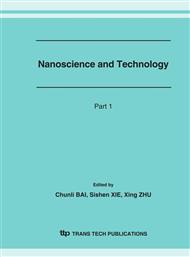p.991
p.995
p.999
p.1003
p.1007
p.1011
p.1017
p.1021
p.1025
The Role of Simulations in Nanoscience, a Case Study: Gold Nanowires
Abstract:
Suspended gold nanowires can be made atomically thin with as many as five atoms, showing extremely large Au-Au bond distances. Using tools derived from Density Functional Theory (DFT) we study many questions posed by the experiments. First we use realistic molecular dynamics simulation to study the mechanisms of formation, evolution and breaking of these atomically thin Au nanowires under stress. We show how defects induce the formation one-atom chains that can grow as long as five-atoms before breaking. Results are in excellent agreement with experiments, except for the resulting shorter bond distances. In order to address this question, we use ab initio electronic structure calculations to show that the exceedingly large Au-Au interatomic distances experimentally obtained could be the effect of impurities. We studied the effect of single impurities H, B, C, N, O, S and small molecules as H2 on the nanowire's electronic and structural properties, in particular how they affect the maximum Au-Au bond length.
Info:
Periodical:
Pages:
1007-1010
Citation:
Online since:
March 2007
Authors:
Keywords:
Price:
Сopyright:
© 2007 Trans Tech Publications Ltd. All Rights Reserved
Share:
Citation:


